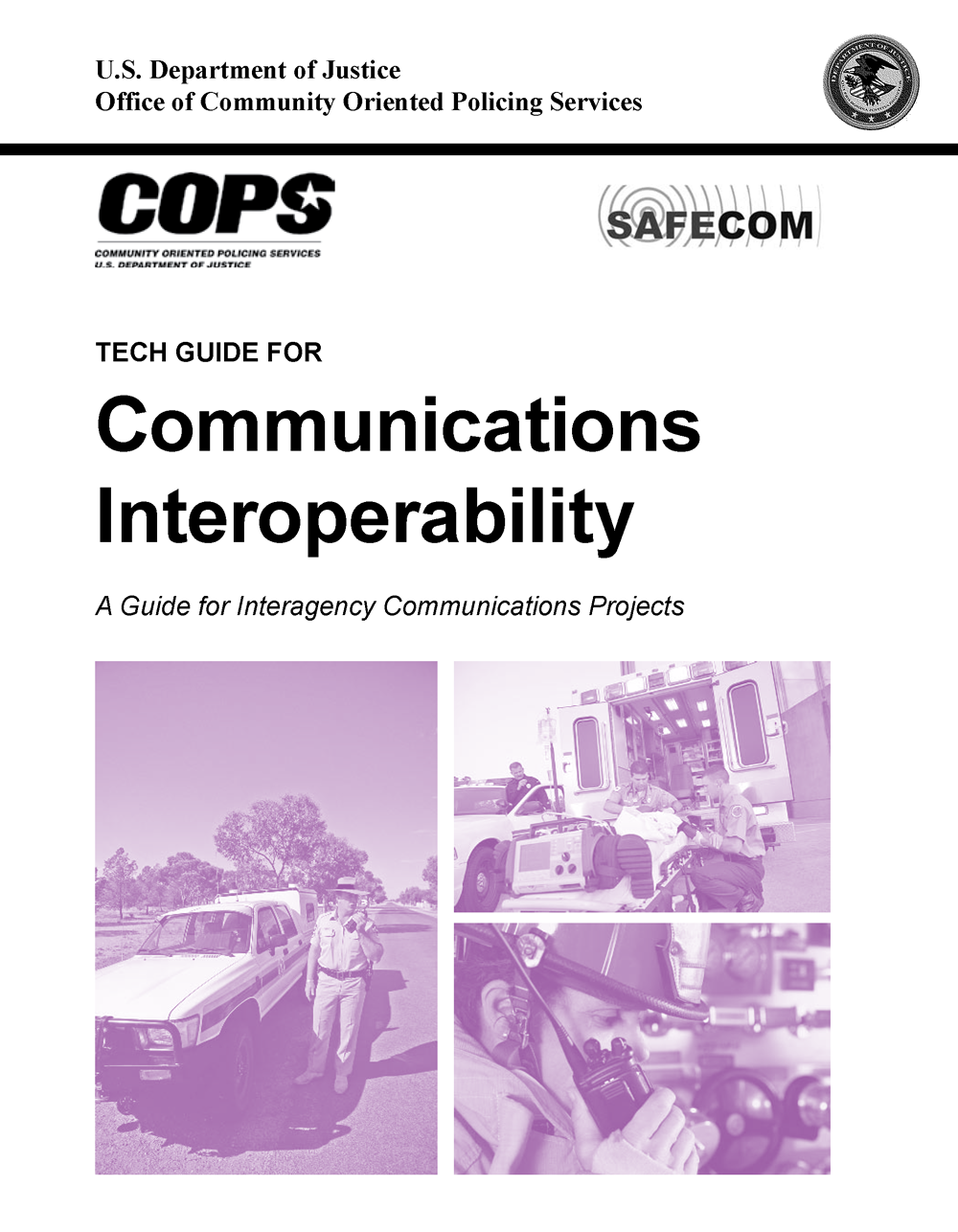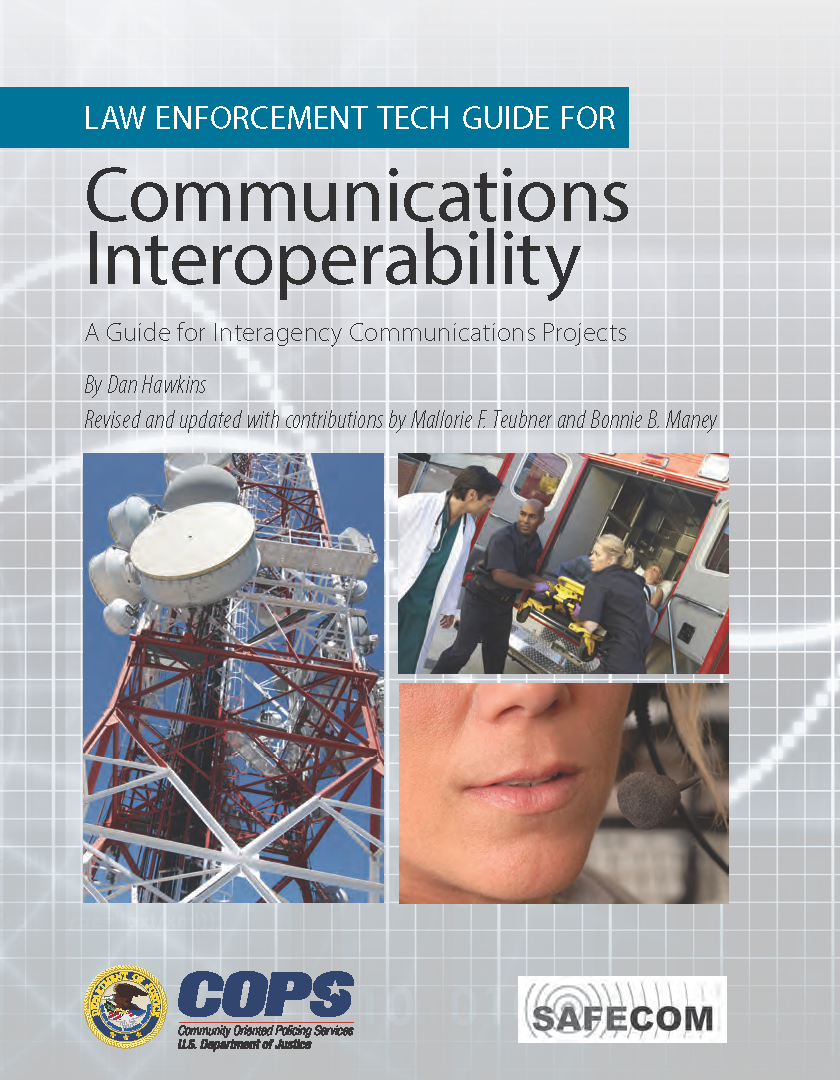New Release: Communications Interoperability Planning Guidebook Updated
When it comes to communications among first responders, discussions around “Why Can’t We Talk”1 has ruled the airwaves since 9/11 and Katrina. These horrific events, as well as other manmade and natural disasters, were exacerbated by and highlighted the nation’s lack of communications interoperability.2 Law enforcement agencies, already well-acquainted with this vulnerability, sought to work with their neighbors to ramp up their interdisciplinary and regional communications capabilities. The COPS Office, along with other federal agencies, supported their efforts with grants and guidance.
 In 2006, the COPS Office released the Law Enforcement Tech Guide for Communications Interoperability. The Guide was written by Dan Hawkins of SEARCH Group, Inc., and endorsed by the Department of Homeland Security SAFECOM Office.
In 2006, the COPS Office released the Law Enforcement Tech Guide for Communications Interoperability. The Guide was written by Dan Hawkins of SEARCH Group, Inc., and endorsed by the Department of Homeland Security SAFECOM Office.
Significant changes in law enforcement’s ability to communicate across disciplines and across jurisdictions have taken place since the Guide’s first printing. For example, the Global Justice Exchange Data Model (GJXDM) morphed into the National Information Exchange Model (NIEM),3 the first National Emergency Communications Plan (NECP)4 made its debut, and the National Broadband Plan5 was released by the Federal Communications Commission.
Today, the COPS Office has released a “revised and updated” version of the Law Enforcement Tech Guide for Communications Interoperability to account for these changes. In this version, author Dan Hawkins is joined by SEARCH contributors Mallorie F. Teubner and Bonnie B. Maney. As with the 2006 printing, DHS SAFECOM was an integral collaborator in the review process, endorsing the Guide in its 2013 form and helping provide a unified federal voice in communications interoperability guidance. The updated edition also benefits from reviews by the Bureau of Justice Assistance and National Council of Statewide Interoperability Coordinators.
 While changes in technology and policy continue to accelerate, the basic planning principles of communications interoperability projects remain as relevant as ever. What are the planning considerations for upgrading a communications system? Should you lease or buy? What about governance? And who is going to pay for it all?
While changes in technology and policy continue to accelerate, the basic planning principles of communications interoperability projects remain as relevant as ever. What are the planning considerations for upgrading a communications system? Should you lease or buy? What about governance? And who is going to pay for it all?
The aim of the Law Enforcement Tech Guide for Communications Interoperability is to help law enforcement, and other first responder agencies, navigate these and other important questions inherent in public safety communications planning. Information is provided in a user-friendly format with sections geared toward executive sponsors, project managers, operational experts, and technical experts (with the understanding that many personnel wear more than one of these hats!). The PDF is available for free download from the COPS Office and SEARCH websites6 and bookmarked to help users quickly find information.
 The Guide is also being made available on the new COPS Office CD, Law Enforcement Tech Guide Resources for Technology Planning. The CD houses the Guide and other products produced by SEARCH for the COPS Office, including Tech Guide companion guidebooks,7 Issue Briefs,8 and podcasts.9 The CD is available through the COPS Response Center at 800-421-6770 or AskCopsRC@usdoj.gov. The CD will also be available at the 2013 International Association of Chiefs of Police Conference COPS Office Booth (#863) on October 19–22, 2013, in Philadelphia, Pennsylvania.
The Guide is also being made available on the new COPS Office CD, Law Enforcement Tech Guide Resources for Technology Planning. The CD houses the Guide and other products produced by SEARCH for the COPS Office, including Tech Guide companion guidebooks,7 Issue Briefs,8 and podcasts.9 The CD is available through the COPS Response Center at 800-421-6770 or AskCopsRC@usdoj.gov. The CD will also be available at the 2013 International Association of Chiefs of Police Conference COPS Office Booth (#863) on October 19–22, 2013, in Philadelphia, Pennsylvania.
Debra R. Cohen McCullough, Ph.D.
Senior Analyst
COPS Office
1 “Why Can’t We Talk,” National Task Force on Interoperability (Washington D.C.: U.S. Department of Justice, National Institute of Justice, 2005). https://www.ncjrs.gov/pdffiles1/nij/204348.pdf.
2 “The 9/11 Commission Report,” www.9-11commission.gov/report/; The Federal Response to Hurricane Katrina: Lessons Learned,” February 2006, http://library.stmarytx.edu/acadlib/edocs/katrinawh.pdf.
3 www.niem.gov
4 www.dhs.gov/xlibrary/assets/national_emergency_communications_plan.pdf
5 www.broadband.gov
6 www.cops.usdoj.gov; www.search.org
7 The (original) Law Enforcement Tech Guide, the Law Enforcement Tech Guide for Small and Rural Police Agencies, the Law Enforcement Tech Guide for Information Technology Security, and the Law Enforcement Tech Guide for Performance Measures that Work.
8 Issue Brief 7 - Developing Interoperability Standard Operating Procedures, Issue Brief 8 - The Accidental Project Manager, Issue Brief 9 - An Introduction to Long Term Evolution (LTE), Issue Brief 10 - Improving Life Cycle Management Through IT Service Management, Issue Brief 11 - Free Project Management Tools, Issue Brief 12 - Using Social Media to Market and Promote Public Safety Projects.
9 “Project Communications with Multiple Stakeholder Groups”; “Data Sharing Between State, Local, and Federal Agencies”; “Partnering and MOU Development”; “Moving Tactical Field Operational Plans from Paper to Practice: Making a System Field Operational”; “Long-Term Governance of Regional CAD/RMS Projects”; “Transitioning from Agency-Owned to Commercial Wireless Data Networks”; “Best Practices in Managing Advanced Communications System Lifecycles”; “Managing the Funding and Finance Challenges of Large Communications Systems Development”; “Why Regional Communications Plans Can Help Improve Systems Planning and Operations.”
Lessons from a Hate Crime Detective | What Can HTCP Do For You? | Responding to Domestic Violence | More De-Escalation Tactics Training | Interoperability Guidebook Updated | COPS at IACP| Meet the Authors!

